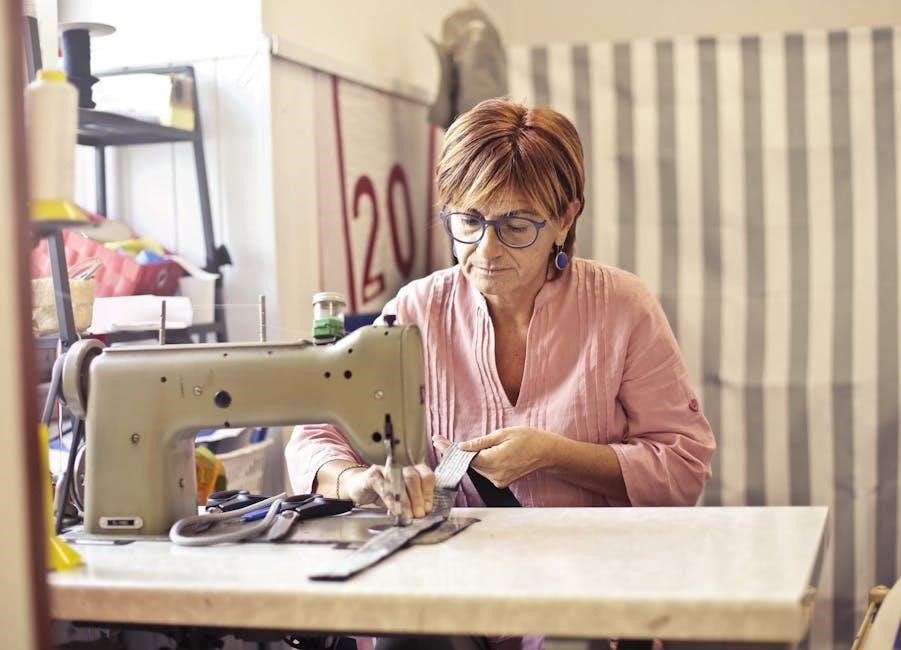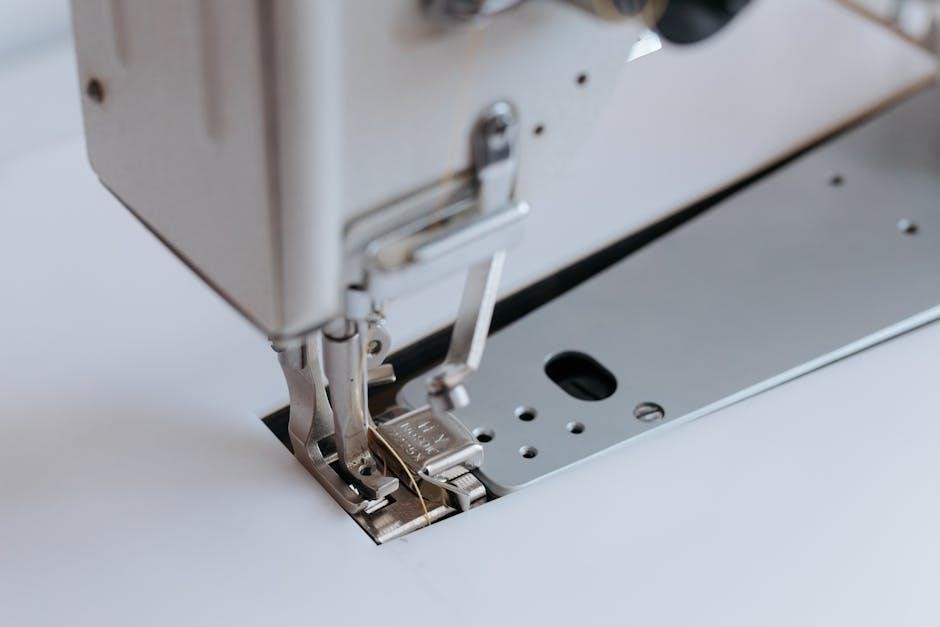Sewing Guides for Sewing Machines: A Comprehensive Guide
Embark on your sewing journey with our comprehensive guide‚ designed to transform beginners into confident creators. We’ll provide detailed instructions‚ helpful tips‚ and easy-to-follow tutorials. Learn essential techniques‚ select the right tools‚ and master your sewing machine for successful projects.
Sewing machines have revolutionized the world of fabric crafts‚ offering a faster‚ more precise alternative to hand sewing. Whether you dream of creating custom garments‚ stylish home décor‚ or personalized gifts‚ understanding the basics of a sewing machine is the first step towards realizing your creative vision. This section introduces you to the fundamental concepts of sewing machines‚ from their history to their basic components.
Sewing machines come in various types‚ each designed for specific tasks and skill levels. Mechanical machines are known for their simplicity and durability‚ making them ideal for beginners. Electronic machines offer more features and stitch options‚ providing greater versatility for intermediate sewers. Computerized machines‚ the most advanced type‚ boast a wide array of automated functions and pre-programmed designs‚ catering to experienced users.
Regardless of the type‚ all sewing machines share common components‚ including a needle‚ bobbin‚ presser foot‚ feed dogs‚ and tension control. Understanding the function of each part is crucial for operating the machine effectively and achieving quality results. The needle pierces the fabric‚ the bobbin supplies the lower thread‚ the presser foot holds the fabric in place‚ the feed dogs move the fabric forward‚ and the tension control regulates the thread tightness.
Essential Tools and Supplies for Sewing
Embarking on your sewing journey requires more than just a sewing machine; it demands a curated collection of essential tools and supplies. These items will not only streamline your workflow but also ensure precision and quality in your projects. Let’s explore the must-have tools and supplies that every beginner sewer should acquire.
First and foremost‚ invest in a good pair of fabric scissors. These scissors are specifically designed for cutting fabric and should never be used for paper or other materials‚ as this will dull the blades. A rotary cutter and cutting mat are also valuable for precise‚ straight cuts‚ especially when working with larger pieces of fabric. A seam ripper is indispensable for correcting mistakes and removing unwanted stitches.
Measuring tools are crucial for accurate pattern cutting and fabric preparation. A flexible measuring tape is essential for taking body measurements and measuring fabric lengths. A clear ruler and a seam gauge are helpful for precise seam allowances and hem depths. Pins are necessary for holding fabric pieces together before sewing‚ and a pin cushion or magnetic pin holder will keep them organized and easily accessible.
Finally‚ stock up on a variety of threads in different colors and materials to match your fabric choices. Select needles appropriate for the type of fabric you’re using‚ and keep extra bobbins on hand for uninterrupted sewing.
Understanding Sewing Machine Basics
Before diving into sewing projects‚ grasping the fundamental components of a sewing machine is crucial. Familiarizing yourself with these parts will empower you to operate the machine effectively and troubleshoot minor issues independently.
The power switch controls the machine’s on/off function‚ while the foot pedal regulates the sewing speed. The needle clamp secures the needle in place‚ and the presser foot holds the fabric against the feed dogs. The feed dogs are small‚ tooth-like structures that move the fabric forward as you sew.
The stitch selector dial allows you to choose different stitch patterns‚ such as straight stitch‚ zigzag stitch‚ or decorative stitches. The stitch length and width controls adjust the size of the stitches. The tension dial regulates the tightness of the thread‚ ensuring balanced stitches.
The bobbin winder fills the bobbin with thread‚ which is then placed in the bobbin case; The handwheel allows you to manually raise and lower the needle. Understanding the purpose of each part will make your sewing experience smoother and more enjoyable. So take some time to explore your machine!
Threading the Sewing Machine: A Step-by-Step Guide
Threading a sewing machine correctly is paramount to achieving consistent and professional-looking stitches. This process may seem daunting initially‚ but with practice and a clear understanding of the steps‚ it will become second nature.
Begin by raising the presser foot and ensuring the needle is in its highest position. Place a spool of thread on the spool pin‚ securing it with a spool cap if available. Guide the thread through the thread guides‚ following the numbered or directional indicators on your machine.
Next‚ thread the tension discs‚ ensuring the thread is properly seated between them. Bring the thread down and around the take-up lever‚ then back up through the eye of the lever. Finally‚ thread the needle from front to back.
Double-check that the thread is correctly positioned in all the guides and tension discs. A properly threaded machine ensures smooth and even stitches‚ preventing skipped stitches and thread breakage. Consult your sewing machine’s manual for specific threading instructions‚ as models may vary slightly.
Winding the Bobbin: A Detailed Tutorial
Winding the bobbin is an essential step in preparing your sewing machine for use. A properly wound bobbin ensures consistent thread delivery and prevents tension issues during sewing. This detailed tutorial will guide you through the process step-by-step.
First‚ place your empty bobbin onto the bobbin winder spindle‚ securing it according to your machine’s instructions. Next‚ position your thread spool on the spool pin and guide the thread through the bobbin winding tension disc‚ usually located near the bobbin winder. Wind the thread around the bobbin several times to secure it.
Engage the bobbin winder mechanism‚ often a lever or switch‚ and start the machine. The bobbin will begin to wind automatically. Monitor the winding process‚ ensuring the thread is winding evenly across the bobbin. Some machines have an automatic stop function that halts winding when the bobbin is full. If yours doesn’t‚ stop the machine when the bobbin is nearly full.
Cut the thread connecting the spool to the bobbin and remove the full bobbin from the winder. Insert the bobbin into the bobbin case‚ following the correct orientation for your machine. Ensure the thread feeds smoothly and freely from the bobbin case. You are now ready to begin sewing!
Basic Stitches: Straight Stitch and Zigzag Stitch
Mastering the straight stitch and zigzag stitch is fundamental to successful sewing. These two basic stitches form the foundation for a wide variety of sewing projects‚ from simple seams to decorative embellishments. Understanding their uses and how to adjust them will greatly enhance your sewing skills.
The straight stitch‚ the most common stitch‚ is used for joining fabrics together along a straight line. Adjust the stitch length according to the fabric’s thickness; shorter stitches for lightweight fabrics and longer stitches for heavier ones. Practice sewing straight lines on scrap fabric to develop accuracy and control.
The zigzag stitch is incredibly versatile. It’s primarily used for finishing raw edges to prevent fraying‚ sewing stretchy fabrics‚ and creating decorative effects. The zigzag stitch width and length can be adjusted to achieve different results. A wider stitch provides more coverage for edge finishing‚ while a narrower stitch is suitable for applique or decorative accents.
Experiment with different stitch settings on various fabrics to understand how they affect the appearance and durability of your seams. With practice‚ you’ll confidently use these stitches to create beautiful and functional projects.
Sewing Machine Needles: Types and Selection
Choosing the correct sewing machine needle is crucial for achieving professional-looking results and preventing damage to your fabric and machine. Needles come in various types and sizes‚ each designed for specific fabrics and sewing tasks. Understanding these differences will significantly improve your sewing experience.
Universal needles are a good starting point for beginners‚ suitable for a wide range of woven fabrics. Ballpoint needles are designed for knit fabrics‚ preventing skipped stitches and runs. Sharp needles are ideal for tightly woven fabrics like microfiber‚ ensuring clean and precise stitching.
Needle sizes range from 60/8 to 120/19‚ with smaller numbers indicating finer needles for delicate fabrics‚ and larger numbers for heavier materials like denim or canvas. Always select the needle size appropriate for your fabric’s weight and thickness. Using the wrong needle can lead to broken needles‚ damaged fabric‚ and poor stitch quality.
Regularly replace your needles‚ as they can become dull or damaged over time. A fresh needle ensures smooth stitching and prevents skipped stitches. Consult your sewing machine manual for specific needle recommendations for your machine model.
Fabric Guide: Choosing the Right Fabric for Your Project
Selecting the appropriate fabric is paramount to the success of any sewing project. Different fabrics possess unique properties‚ impacting drape‚ texture‚ and overall suitability for various garments or items. Understanding these characteristics will empower you to make informed decisions and achieve desired results.
Cotton is a versatile and beginner-friendly option‚ ideal for a wide range of projects. Linen offers a crisp‚ textured look‚ perfect for summer clothing. Knit fabrics‚ such as jersey or fleece‚ provide stretch and comfort‚ suitable for activewear or casual garments. Silk offers elegance and drape‚ often used for special occasion wear.
Consider the fabric’s weight‚ fiber content‚ and weave when making your selection. Lightweight fabrics are best for flowing garments‚ while heavier fabrics provide structure and durability. Always pre-wash your fabric to prevent shrinkage and color bleeding after sewing.

For beginners‚ start with easy-to-handle fabrics like cotton or linen. As you gain experience‚ experiment with different textures and weights to expand your sewing capabilities. Remember to consult patterns for fabric recommendations to ensure compatibility and a successful outcome.
Beginner Sewing Projects: Easy Patterns and Tutorials
Embarking on your sewing journey with simple‚ rewarding projects is key to building confidence and mastering fundamental skills. Numerous easy patterns and tutorials are available online‚ perfect for beginners eager to create their first handmade items. Start with projects that require minimal steps and straight-line sewing.
Consider making a simple tote bag‚ a pillowcase‚ or a basic skirt. These projects involve straightforward construction techniques and are excellent for practicing essential stitches. Online tutorials often provide step-by-step instructions and visual aids‚ guiding you through each stage of the process.

Look for patterns specifically designed for beginners‚ featuring clear diagrams and easy-to-understand language. Many websites and blogs offer free patterns and tutorials‚ allowing you to experiment without significant investment. As you progress‚ gradually tackle more complex projects with curves and intricate details.
Don’t be afraid to make mistakes! Sewing is a learning process‚ and every project offers an opportunity to improve your skills. Embrace the challenge‚ celebrate your accomplishments‚ and enjoy the satisfaction of creating something unique with your own hands.
Troubleshooting Common Sewing Machine Problems

Even experienced sewers encounter occasional issues with their machines. Understanding common problems and their solutions can save time and frustration. One frequent issue is thread breakage‚ often caused by incorrect threading‚ a damaged needle‚ or poor-quality thread. Ensure the machine is properly threaded‚ use a new needle appropriate for the fabric‚ and try a different thread brand.
Another common problem is skipped stitches‚ which can result from a bent needle‚ incorrect needle size‚ or improper tension settings. Replace the needle‚ select the correct size for the fabric‚ and adjust the tension dial. Bobbin issues‚ such as uneven winding or improper insertion‚ can also cause problems.
Make sure the bobbin is correctly wound and inserted into the machine. Fabric feeding problems can occur if the feed dogs are lowered or obstructed. Check the feed dogs and adjust the presser foot pressure. Regular cleaning and maintenance can prevent many issues.
Remove lint and debris from the bobbin area and needle plate. If problems persist‚ consult your sewing machine manual or seek assistance from a qualified technician.
Tips and Tricks for Better Sewing Results
Achieving professional-looking sewing results involves mastering a few key tips and tricks. Accurate cutting is crucial; always use sharp scissors or a rotary cutter and a cutting mat. Pre-washing your fabric prevents shrinkage and ensures a better fit in the finished garment. Pressing seams as you sew creates a clean‚ crisp finish.
Use the correct presser foot for the task‚ such as a zipper foot for inserting zippers or a rolled hem foot for creating neat hems. Practice sewing straight lines and curves on scrap fabric to improve your control. When sewing with delicate fabrics‚ use a fine needle and a lightweight stabilizer.
For bulky fabrics‚ increase the stitch length and use a walking foot to ensure even feeding. Clipping curves and notching corners reduces bulk and allows the fabric to lay flat. Understitching helps prevent facings from rolling to the outside.

Always backstitch at the beginning and end of a seam to secure the stitches. Experiment with different stitch settings to achieve the desired effect. With practice and attention to detail‚ you can elevate your sewing skills and create beautiful‚ well-made projects.
Advanced Sewing Techniques
Once you’ve mastered the basics‚ you can explore advanced sewing techniques to elevate your projects. Pattern alteration allows you to customize designs for a perfect fit. Learn to adjust for different body shapes‚ lengthen or shorten garments‚ and modify design elements to suit your personal style. Constructing lined garments adds durability and a professional finish.
Master the art of inserting invisible zippers for a seamless closure. Explore techniques like tailoring‚ which involves shaping and molding fabric to create structured garments. Learn to sew with knits‚ using specialized stitches and needles to accommodate the fabric’s stretch. Experiment with couture techniques‚ such as hand-sewing‚ intricate embellishments‚ and custom finishes.
Drafting your own patterns opens up a world of creative possibilities. Learn the principles of pattern making and create unique designs from scratch. Explore advanced seam finishes‚ such as French seams and bound seams‚ for a polished interior. Mastering these advanced techniques will enhance your sewing skills and allow you to create truly exceptional garments and projects.
Consider taking workshops or online courses to further your knowledge and refine your skills.
Resources for Learning More About Sewing
To deepen your sewing knowledge‚ numerous resources are available both online and in person. Websites like Treasurie and various sewing blogs offer tutorials‚ tips‚ and free patterns for all skill levels. YouTube channels provide visual demonstrations of techniques and project walkthroughs. Online learning platforms such as Skillshare and Coursera offer comprehensive sewing courses taught by experienced instructors.
Local fabric stores often host workshops and classes for beginners and advanced sewers alike. Sewing guilds and clubs provide opportunities to connect with fellow enthusiasts‚ share knowledge‚ and participate in group projects. Libraries offer a wealth of sewing books and magazines covering a wide range of topics.
Consider investing in a good‚ basic sewing book for reference. Explore the Brother YouTube channel for helpful sewing tutorials. Don’t hesitate to seek advice from experienced sewers in online forums or local communities. Embrace the learning process and enjoy the journey of expanding your sewing skills.
Remember that continuous learning is key to becoming a confident and skilled sewer. Explore these resources and find the learning methods that best suit your style and preferences.

